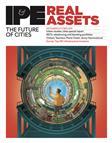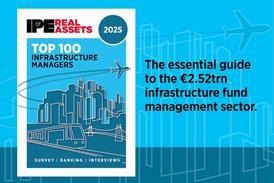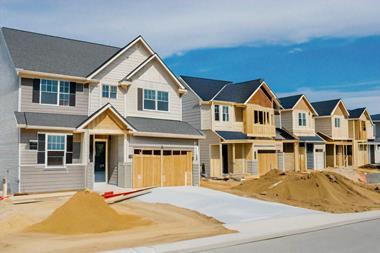The risks to the US economy are primarily downside but unlike previous downturns at least there is no overbuilding problem. In this special report on the US Bret Wilkerson and Jeff Havsy look at what has happened in the US and consider the outlook for this year
US economic growth slowed markedly in the fourth quarter, to an estimated annualised rate of 0.6%, although total economic growth for 2007 was down only slightly from 2006, to less than 2.5%. It is likely that the US has now entered a recession, and conventional wisdom is that GDP growth will be negative for at least the first half of the year. Exports are a bright spot: they have solidly contributed to overall GDP growth, offsetting much of the drag from housing over the past few quarters.
The struggling consumer may finally be tapped out in 2008. Personal consumption makes up about 70% of US GDP; however, the last three quarters have shown that the consumer is having a harder time supporting the economy. Weak housing and employment markets are undermining confidence. The government stimulus package will likely help, but since most rebate checks won't even arrive until later in May or June, the first half of the year will likely show contraction. In fact, through March, retail sales growth is the lowest since early 2002, and real retail sales are now actually contracting, by -0.7% year-over-year.
Residential investment remains a drag on the economy. Serious excess new construction marketing in recent years surpasses levels last seen before the 1991 recession. When every developer with a piece of land is pitching new supply, you are at the top of the market. Very tight credit caused by volatility in the financial markets is compounding the excess supply issue and further damaging consumer demand.
Clearly, only significantly lower home prices and stabilised credit conditions will help abate the housing drag. This will certainly take some time to work itself out, and we'll see housing continuing to drag down growth, possibly into 2009.
In a somewhat positive report, the US Census Bureau noted that housing starts posted their largest decline in over 27 years in January. And data for the housing market in February and March show some hopeful signs. This slower pace of new construction should help to alleviate some surplus supply, which at present absorption rates represents roughly 10 months of new supply available. Historically, the average housing inventory ranges between 4.5 (2005 average) and 6.5 (2006 average) months of supply. As inventories correct and new households begin to absorb existing supply, starts should begin to rise again in the beginning of 2009 as demand stabilises and home prices bottom out.
Businesses stepped in to spend much of what the consumer couldn't in 2007. Corporate profits moved to record highs and, throughout most of the year, demand prospects were viewed as good. However, the credit crunch and subsequent recessionary woes have drained both corporate profits and business confidence. While corporate profits are up 2.5% year-over-year, they actually declined at a 12.4% annualised rate between the third and fourth quarters of 2007, mostly due to sizeable write-offs at financial institutions, which offset continued profit expansion in most other industries.
Recognising the slowing economy and reacting to the sub-prime market seizure, the Fed initiated incredibly aggressive policy measures. Since the end of August, the Fed has lowered the Funds rate by 300bps and the discount rate by 375bps to stave off recession. However, these measures caused the dollar to fall further and inflation risks to rise significantly. By first quarter 2008, the Fed had also acted aggressively to address a much broadened credit crunch by pumping money into the monetary system and offering short-term financing to distressed banks. It is likely that later this year, after the markets have stabilised, the Fed will be forced to address the inflation issue.
From 1970 onwards, when US job growth was decelerating and dipped below 1.2% year- over-year, which it did in July of last year, a recession followed every time. Job growth averaged 95,000 new jobs per month in 2007, according to the Bureau of Labor Statistics' final numbers. Job growth in 2007 was weaker than initially reported and way off the 2006 job growth numbers, which averaged roughly 175,000 per month. The first three months of 2008 have revealed further job losses of 232,000, another strong indicator that the US has entered a recession.
The risks to the US economy are primarily on the downside, with a credit crunch, an employment market, and consumer spending that arguably can worsen further. All in all, 2008 will be a tale of two halves, with a contracting economy in the first part and a slow recovery expected in the second. Monetary and fiscal as well as other policy stimuli should prevent a prolonged downturn, but the expected recovery is contingent upon global financial market stability by the summer months.
According to the National Council of Real Estate Investment Fiduciaries (NCREIF), net operating incomes for US commercial real estate rose by 14% in 2007, driven by both rising occupancies and rent levels. During the first half of the year, space market fundamentals drove momentum upwards, but by the turn of 2008, markets and expectations were weakening.
The best news is that there is not a major overbuilding problem. As a percentage of inventory, office had 2.7% underway at the peak in 2007 compared with 4.4% at the peak of the last cycle. Warehouse peaked at 2.2% last year compared with 3.2% in the last cycle, and apartment, 1.7%, versus 2.7% last time. Retail is the only property type where supply is similar to that in the last cycle, with a peak of 3.5% last year and 3.9% in the last cycle. Construction in all four property types is well below the massive overbuilding of the cycle in the late 1980s. With tightening in the credit markets, new construction starts have fallen dramatically, and the next few years look much better.
Demand was strong for all four property types in 2007, but off from 2006's levels, excluding apartment. As a result, rent growth in this cycle peaked and is starting to trend downward. Apartment rent growth peaked in 2006 at 5.3%, fell to 4.7% last year, and is forecast to fall to 1.6% in 2008. Warehouse followed a similar pattern, falling from 4% to 2.8%, and will likely finish 2008 0.4% above where it started. Office rent growth peaked in 2007 at 7.9% and will flatten for the next two years. Retail rents actually turn negative in 2008, going from 1.7% to -0.8%.
Credit markets in 2007 took a sharp blow from a severe re-pricing of risk. The flood of capital into every corner of the capital markets in recent years pushed risk premia down to historical llows in many fixed-income asset classes. As current yields in both commercial real estate debt and equity markets got pushed down to minuscule spreads over the risk-free rate, the margin for error got extremely slim, exposing the market to "event risk". In 2007, the event happened: its name was sub-prime.
In 2008, the rewards for taking risk appear to be much greater. Since the beginning of the year, yields on AAA CMBS bonds are higher than yields on BBB bonds were only one year earlier. Notably, while overpriced in the beginning of 2007, in select segments credit is still underpriced in the beginning of 2008. As greed turns into fear, risk aversion has swept over many parts of the capital markets, and the beginnings of opportunity are emerging.
Capital flooded to the market in recent years, enticed by strong returns and enabled by aggressive CMBS and CDO bond buyers. This liquidity pushed down lending spreads and yields on CMBS bonds to record-tight levels: at the beginning of 2007, AAA spreads were in the range of 20-30bps over swaps. In February 2008, AAA-rated bonds were about 200bps over this benchmark, a trend that holds true all the way down the debt stack.
After the market slapped lenders' hands in 2007, they quickly retreated. As of the fourth quarter, approximately 80% of commercial real estate senior loan officers surveyed by the Federal Reserve said they were tightening standards. That number is higher than the percentage tightening in the single-family housing market, whose pain dwarfs that on the commercial side. The effects of this are numerous and immediate: pickier lenders mean higher debt service coverage ratios and lower LTVs. This lowers the return on equity unless prices adjust in kind. Tighter standards are also causing higher borrowing costs and putting upward pressure on cap rates and downward pressure on prices.
With very little volume in the CMBS market, balance sheet lenders must absorb activity. But these lenders have limited capacity. Life insurers are constrained by liability-matching needs and other sources (banks, foreign lenders, pension funds) quite often see more value (with lower capital costs) in owning the AAA security than in originating a new loan. Given the dearth of debt capital, a weak economic outlook, uncertainty in underwriting, and general malaise surrounding the market, investors should expect transaction volume in 2008 to look something like that in 2004, when approximately $75bn (€48bn) of volume was completed.
Yields had been steadily falling in all four property types for most of this decade. As of the beginning of 2008, transaction cap rates themselves have moved only moderately upward. One of the primary reasons for this is likely that only the best of properties are selling today. Although yield expansion has been mild so far, risk premiums have increased dramatically, and yields will grow further. As a result, with skittishness in the debt markets, weaker underlying commercial real estate fundamentals, and yield decompression, equity investors in the commercial real estate market in the US are likely to achieve relatively poor returns in the near future. However, as pricing adjusts, opportunities will begin to emerge towards the end of this year in all sectors. Therefore, geographic selection will be the key to good performance.
Bret Wilkerson is CEO, and Jeff Havsy is global strategist, Property and Portfolio Research












